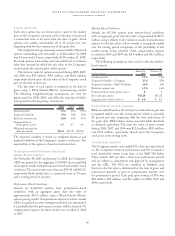American Express 2008 Annual Report Download - page 98
Download and view the complete annual report
Please find page 98 of the 2008 American Express annual report below. You can navigate through the pages in the report by either clicking on the pages listed below, or by using the keyword search tool below to find specific information within the annual report.
notes to consolidated financial statements
american express company
96
The following table presents the risk–based capital ratios for the Company and its significant banking subsidiaries at December 31, 2008:
(Millions, except percentages)
Well-capitalized
ratios(c)
Minimum capital
ratios(c)
American
Express Company
American Express
Centurion Bank
American
Express Bank, FSB(f)
Tier 1 capital $10,087 $3,029 $3,415
Total capital $11,610 $3,386 $3,767
Tier 1 capital ratio 6.0% 4.0% 9.7% 12.3% 12.7%
Total capital ratio 10.0% 8.0% 11.1% 13.7% 14.0%
Tier 1 leverage ratio(a)(b) 5.0%(d) 4.0%(e) 8.5% 13.2% 12.2 %
(a) Average adjusted assets for purposes of calculating the leverage ratio include total average assets for most recent quarter adjusted for unrealized gains/losses on debt
securities less deductions for disallowed goodwill and other intangible assets that are subject to deductions from Tier 1 capital.
(b) American Express Bank, FSB leverage ratio represents Tier 1 core capital ratio, calculated similarly to Tier 1 leverage ratio.
(c) As defined by the regulations issued by the Federal Reserve Board, Office of the Comptroller of the Currency (OCC), OTS and FDIC.
(d) Represents requirements for banking subsidiaries pursuant to regulations issued under the Federal Deposit Insurance Corporation Improvement Act. There is no
Tier 1 leverage component in the definition of a well-capitalized bank holding company.
(e) The minimum Tier 1 leverage ratio for bank holding companies and banks is 3 percent or 4 percent depending on factors specified in regulations issued by the
Federal Reserve Board and OCC.
(f) Subsequent to December 31, 2008, the Company infused $500 million of additional capital into FSB.
As previously discussed, the Company participated in
the CPP on January 9, 2009, which will increase its
Tier 1 capital by $3.39 billion effective that date and not
reflected in the capital ratios presented above. Refer to Note 27
for further discussion.
Restricted Net Assets of Subsidiaries
Certain of the Company’s subsidiaries are subject to restrictions
on the transfer of net assets under debt agreements and
regulatory requirements. These restrictions have not had any
effect on the Company’s shareholder dividend policy and
management does not anticipate any impact in the future.
Procedures exist to transfer net assets between the Company
and its subsidiaries, while ensuring compliance with the various
contractual and regulatory constraints. At December 31, 2008,
the aggregate amount of net assets of subsidiaries that may not
be transferred to American Express’ Parent Company (Parent
Company) was approximately $7 billion.
The Company was not previously required to calculate risk-
based capital ratios or a leverage ratio. The methodology of
calculating these ratios may be refined over time.
The Company’s two U.S. Bank operating subsidiaries,
Centurion Bank and FSB, are subject to various regulatory
capital requirements of the FDIC and the Office of Thrift
Supervision (OTS). Failure to meet minimum capital
requirements can initiate certain mandatory, and possibly
additional, discretionary actions by regulators, that, if
undertaken could have a direct material effect on Centurion
Bank and FSB’s financial statements.
Bank Holding Company Dividend Restrictions
As a bank holding company, the Company is limited in its
ability to pay dividends by its regulators who could prohibit
a dividend that would be considered an unsafe or unsound
banking practice. It is the policy of the Federal Reserve that
bank holding companies should generally pay dividends on
common stock only out of earnings, and only if prospective
earnings retention is consistent with the organization’s expected
future needs, asset quality, and financial condition. Moreover,
bank holding companies should not maintain dividend levels
that undermine a company’s ability to be a source of strength
to its banking subsidiaries. The Federal Reserve has indicated
that bank holding companies should carefully review their
dividend policy and has discouraged dividend pay-out ratios
that are at 100 percent unless both asset quality and capital are
very strong.
























